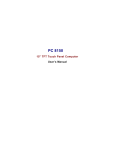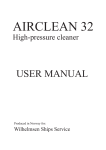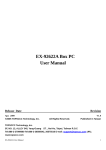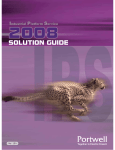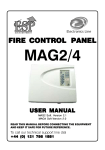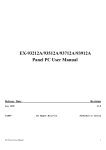Download PANEL1158-822 15” TFT Slim Industrial Panel PC User`s Manual
Transcript
PANEL1158-822 15” TFT Slim Industrial Panel PC User’s Manual Disclaimers This manual has been carefully checked and believed to contain accurate information. AXIOMTEK Co., Ltd. assumes no responsibility for any infringements of patents or any third party’s rights, and any liability arising from such use. AXIOMTEK does not warrant or assume any legal liability or responsibility for the accuracy, completeness or usefulness of any information in this document. AXIOMTEK does not make any commitment to update the information in this manual. AXIOMTEK reserves the right to change or revise this document and/or product at any time without notice. No part of this document may be reproduced, stored in a retrieval system, or transmitted, in any form or by any means, electronic, mechanical, photocopying, recording, or otherwise, without the prior written permission of AXIOMTEK Co., Ltd. Copyright 2008 AXIOMTEK Co., Ltd. All Rights Reserved September 2008, Version A1 Printed in Taiwan ii Safety Approvals u CE Marking u FCC Class A u FCC Compliance This equipment has been tested in compliance with the limits for a Class A digital device, pursuant to Part 15 of the FCC Rules. These limits are meant to provide reasonable protection against harmful interference in a residential installation. If not installed and used in accordance with proper instructions, this equipment might generate or radiate radio frequency energy and cause harmful interference to radio communications. However, there is no guarantee that interference will not occur in a particular installation. If this equipment does cause harmful interference to radio or television reception, which can be determined by turning the equipment off and on, the user is encouraged to try to correct the interference by one or more of the following methods: 1. Reorient or relocate the receiving antenna. 2. Increase the separation between the equipment and receiver. 3. Connect the equipment to another outlet of a circuit that doesn’t connect with the receiver. 4. Consult the dealer or an experienced radio/TV technician for help. Shielded interface cables must be used in order to comply with the emission limits. iii Safety Precautions Before getting started, please read the following important safety precautions. 1. 2. 3. 4. 5. 6. 7. 8. iv The PANEL1158-822 Series does not come equipped with an operating system. An operating system must be loaded first before installing any software into the computer. Be sure to ground yourself to prevent static charge when installing the internal components. Use a grounding wrist strap and place all electronic components in any staticshielded devices. Most electronic components are sensitive to static electrical charge. Disconnect the power cord from the PANEL1158-822 Series before any installation. Be sure both the system and external devices are turned OFF. A sudden surge of power could ruin sensitive components that the PANEL1158-822 Series must be properly grounded. The brightness of the flat panel display will be getting weaker as a result of frequent usage. However, the operating period varies depending on the application environment. Turn OFF the system power before cleaning. Clean the system using a cloth only. Do not spray any liquid cleaner directly onto the screen. The PANEL1158-822 Series may come with or w/o a touchscreen. Although the touchscreen is chemical resistant, it is recommended that you spray the liquid cleaner on a cloth first before wiping the screen. In case your system comes without the touchscreen, you must follow the same procedure and not spray any cleaner on the flat panel directly. Avoid using sharp objects to operate the touchscreen. Scratches on the touchscreen may cause malfunction or internal failure to the touchscreen. The flat panel display is not susceptible to shock or vibration. When assembling the PANEL1158-822 Series, make sure it is securely installed. Do not open the system’s back cover. If opening the cover for maintenance is a must, only a trained technician is allowed to do so. Integrated circuits on computer boards are sensitive to static electricity. To avoid damaging chips from electrostatic discharge, observe the following precautions: l l Before handling a board or integrated circuit, touch an unpainted portion of the system unit chassis for a few seconds. This will help to discharge any static electricity on your body. When handling boards and components, wear a wristgrounding strap, available from most electronic component stores. Trademarks Acknowledgments AXIOMTEK is a trademark of AXIOMTEK Co., Ltd. IBM, PC/AT, PS/2, VGA are trademarks of International Business Machines Corporation. ® ® Intel and Pentium are registered trademarks of Intel Corporation. MS-DOS, Microsoft C and QuickBASIC are trademarks of Microsoft Corporation. VIA is a trademark of VIA Technologies, Inc. SST is a trademark of Silicon Storage Technology, Inc. UMC is a trademark of United Microelectronics Corporation. Other brand names and trademarks are the properties and registered brands of their respective owners. v Table of Contents Disclaimers ........................................................................................................ ii Safety Approvals............................................................................................... iii Safety Precautions............................................................................................ iv Chapter 1 Introduction .......................................................................... 1 1.1 1.2 1.2.1 1.2.2 1.2.3 1.3 1.4 1.4.1 1.4.2 1.5 General Description........................................................................ 2 System Specifications .................................................................... 3 Main CPU Board ............................................................................ 3 I/O System .................................................................................... 3 System Specification ..................................................................... 4 Dimensions .................................................................................... 5 Front View and I/O Outlets ............................................................. 7 Front View ..................................................................................... 7 I/O Outlets..................................................................................... 8 Package List................................................................................... 9 Chapter 2 Hardware Installation ....................................................... 11 2.1 2.2 2.3 2.4 2.5 2.6 2.6.1 2.6.2 2.6.3 Installing the CPU and DRAM ...................................................... 11 Installing the the Hard Disk Drive ................................................. 14 Serial Port Interface...................................................................... 18 VGA ............................................................................................. 19 Ethernet ....................................................................................... 20 Mountings Way – Panel/Wall/Rack .............................................. 21 Panel Mounting ........................................................................... 21 Wall Mounting ............................................................................. 22 Rack Mount ................................................................................ 23 Chapter 3 Phoenix-Award BIOS Utility ............................................ 24 3.1 3.2 3.3 3.4 3.5 3.6 3.7 3.8 3.9 3.10 3.11 3.12 3.13 3.14 3.15 3.16 vi Entering Setup ............................................................................. 24 Control Keys................................................................................. 25 Getting Help ................................................................................. 25 The Main Menu ............................................................................ 26 Standard CMOS Setup Menu ....................................................... 27 Advanced BIOS Features............................................................. 29 Advanced Chipset Features ......................................................... 34 Integrated Peripherals .................................................................. 36 Power Management Setup ........................................................... 42 PnP/PCI Configuration Setup ....................................................... 45 PC Health Status.......................................................................... 47 Frequency/Voltage Control ........................................................... 48 Load Optimized Defaults .............................................................. 49 Set Supervisor/User Password..................................................... 50 Save & Exit Setup ........................................................................ 51 Exit Without Saving ...................................................................... 52 Chapter 4 Driver Installation .............................................................. 54 4.1 4.2 4.2.1 4.2.2 4.2.3 System ......................................................................................... 54 Touch Screen............................................................................... 55 Specification................................................................................. 55 Driver Installation – Windows 2000/XP/Vista.................................... 56 Driver Installation - DOS .................................................................. 59 Appendix Power Supply Specification ............................................ 62 vii MEMO viii PANEL1158-822 User’s Manual Chapter 1 Introduction This chapter contains general information and detailed specifications of the PANEL1158-822. Chapter 1 includes the following sections: n n n n n General Description System Specification Dimensions Front View & I/O Outlets Package List Introduction 1 PANEL1158-822 User’s Manual 1.1 General Description The PANEL1158-822 Series is a TFT Touch Panel PC, equipped with superior Pentium ® M/Celeron ® M processors and 15” XGA LCD display. The paradigmatic industrial panel computer, PANEL1158-822, is a complete full-function and extreme cost-effective industrial HMI controller. This ideal industrial-grade panel computer PANEL1158-822 can be applied to many industrial or commercial projects, such as transportation, factory automation, HMI machine controller, Point Of Sales, KIOSK, and more. Moreover, PANEL1158-822 provides highly reliable and highly flexible industrial-grade products in all-in-one solutions. 2 Introduction PANEL1158-822 User’s Manual 1.2 System Specifications 1.2.1 Main CPU Board l CPU n ® ® Socket 478 for Pentium M/ Celeron M processors with FSB 400 MHz l l System Chipset ® n Intel 910GMLE + ICH6M BIOS n l Phoenix-Award BIOS, 4Mbit with RPL/PXE LAN Boot ROM, SmartView and Customer CMOS Backup System Memory n Two 240-pin DDR2 DIMM maximum up to 2GB l L2 Cache n Integrated in CPU l Bus Clock n 400 MHz l Watchdog Timer n Up to 255 levels as Reset feature 1.2.2 l l I/O System Standard I/O n Five serial ports with power (5 x RS-232) n One PS/2 for Keyboard Interface n One PS/2 for Mouse Interface n Four USB Ports 2.0 compliant n One VGA Output Ethernet n Two RTL8111B Gigabit Ethernet Introduction 3 PANEL1158-822 User’s Manual l Audio l n HD Audio for two channels output n MIC-In, Line-Out Storage n l Two SATA-150 interface Box-Header 1.2.3 n One 26-pin for shared LPT n One PATA-100 with 40-pin box-header System Specification l 15” TFT LCD l 5-wire Analog Resistive type Touchscreen l Disk Drive Housing n One internal 3.5” drives (or 2 X 2.5” HDD) l AC Power Supply 4 Introduction PANEL1158-822 User’s Manual l Heat Dispensing Design l Net Weight n l 10 Kgs Dimension (Main Body Size) n l 420mm (16.53”)(W) x 86.4mm (3.40”)(D) x 335mm (13.19”)(H) Operation Temperature n 0℃to 45℃; Relative Humidity 50% l Relative Humidity n 10% to 85% @ 40℃, Non-Condensing l Altitude n l Vibration (Operating) n l 10,000 ft. (3,000 meters) 10 to 500 Hz, 1 G random Shock (Operating) n 10 G peak acceleration (11 msec. duration) NOTE All specifications and images are subject to change without notice. 1.3 Dimensions This diagram shows you dimensions and outlines of the PANEL1158822. Introduction 5 PANEL1158-822 User’s Manual 1.4 1.4.1 Front View and I/O Outlets Front View Please refer to the following illustration for features and controls of the PANEL1158-822 front bezel. No Introduction Function 1 SEL+ 2 SEL- 3 Backlight ON/OFF 7 PANEL1158-822 User’s Manual 1.4.2 I/O Outlets The following figure shows the I/O locations of the PANEL1158-822. No 8 Connector No Connector 1 PS/2 8 Mic-in, Line-Out 2 COM 1 9 COM 5 3 COM 2 10 COM 6 4 COM 3 11 Power Switch 5 VGA 12 AC power 6 Giga LAN x 2 13 Ground 7 USB v2.0 x 4 Introduction PANEL1158-822 User’s Manual 1.5 Package List The package bundled with your PANEL1158-822 should contain the following items: l l l l l l l l l l P1158-822 x 1 AC power cord x 1 Panel mount kit x 7 Driver CD x1 Socket 478 CPU cooler x 1 SATA Cable x 1 Small HDD Kit for 2.5” HDD (Optional) VIA WLAN Kit (Optional) W all / VESA mount bracket kit x 1 (Optional) Rack mount bracket kit x 1 (Optional) If you can not find this package or any items are missing, please contact AXIOMTEK distributors immediately. Introduction 9 PANEL1158-822 User’s Manual MEMO 10 Introduction PANEL1158-822 User’s Manual Chapter 2 Hardware Installation The PANEL1158-822 is convenient for your various hardware configurations in flexible ways, such as CPU (Central Processing Unit), HDD (Hard Disk Drive), Memory Module (DRAM), and more. The chapter 2 will show you how to install the hardware. It includes: n n n n n n n 2.1 CPU DRAM Hard Disk Serial Port VGA Ethernet Mounting Ways Installing the CPU and DRAM ® ® The standard PANEL1158-822 system is designed for Intel Celeron M processors. The built-in CPU board provides two 240-pin DDR2 DIMM sockets that support system memory up to 2GB. Please refer to the instructions below, illustrated with concise images, to upgrade the CPU, DRAM step by step: Step 1 Turn off the system. Step 2 Unplug the AC power-cord.. Hardware Installation 11 PANEL1158-822 User’s Manual Step 3 Locate screws on the rear chassis as illustrated, and unscrew to open it. Step 4 Remove the rear chassis, and the CPU and DDR DRAM inside the system. Accordingly, you can install the CPU and DDR DRAM. CPU DRAM 12 Hardware Installation PANEL1158-822 User’s Manual Step 5 Close the rear chassis, and fasten all screws. Hardware Installation 13 PANEL1158-822 User’s Manual 2.2 Installing the the Hard Disk Drive The PANEL1158-822 offers a convenient drive bay module for users to install HDD. The system offers users one 3.5” Hard Disk Drives for installation. If you want to install one or two 2.5” HDD, the PANEL1158-822 also provides the 2.5” drive holder to meet your requirement. Please follow the steps: Note The hardware limitation is the 2.5” HDD and 3.5” HDD CAN NOT exist simultaneously. Step 1 Turn off the system. Step 2 Unplug the AC power-cord. Step 3 Locate screws on the rear chassis as illustrated, and unscrew to open it. 14 Hardware Installation PANEL1158-822 User’s Manual Step 4 Loosen these screws from the HDD drive bracket, and take out HDD bracket kit to install 3.5” HDD. Step 5 Fix the Hard Disk to the HDD bracket and connect the cable to complete the installation. Hardware Installation 15 PANEL1158-822 User’s Manual Ø Installing 2.5” HDD If installing the 2.5” HDD, please follow the steps: Step 1 Change HDD bracket from 3.5” to 2.5” 16 Hardware Installation PANEL1158-822 User’s Manual Step 2 Set the 2.5” HDD in the HDD bracket kit. Step 3 Install the HDD into the PANEL1158-822. Hardware Installation 17 PANEL1158-822 User’s Manual 2.3 Serial Port Interface The PANEL1158-822 has five serrial ports, COM1, COM2, COM3, COM5, COM6 are RS-232 Port Connector. The connector, COM1, COM2, COM3, COM5, COM6 are DB-9 connector, and the following table shows the pin assignments of this connector. Pin Signal Pin Signal 1 DCD, Data Carrier Detect 6 DSR, Data Set Ready 2 RXD, Receive Data 7 RTS, Request To Send 3 TXD, Transmit Data 8 CTS, Clear To Send 4 DTR, Data Terminal Ready 9 RI/+5V/+12V Ring Indicator 5 GND, Ground NOTE COM4 is reserved for touch controller used. 18 Hardware Installation PANEL1158-822 User’s Manual 2.4 VGA The PANEL1158-822 has an analog RGB interface connector. It is able to connect to an expansion CRT monitor, and the system can display on both the flat panel and the CRT simultaneously Pin 1 2 3 4 5 Signal 6 Red Green Blue N.C Ground (GND) AnalogGround(AGND) 7 AnalogGround(AGND) 8 AnalogGround(AGND) 9 10 11 12 13 14 15 N.C Ground (GND) N.C DDC DATA Horizontal Sync Vertical Sync DDC CLK VGA Hardware Installation 19 PANEL1158-822 User’s Manual 2.5 Ethernet The PANEL1158-822 provides a NE2000 compatible Ethernet (RJ-45) interfaces. For network connection, just plug in one cable end of the system’s 10/100/1000-Base-T Hub into a standard RJ-45 connector. Please refer to detailed pin assignment list below: Pin Signal 1 2 TX+ (Data transmission positive TX- (Data transmission negative) Rx+(Data reception positive) RJ45 termination RJ45 termination Rx- (Data reception negative) RJ45 termination RJ45 termination 3 4 5 6 7 8 20 1 2 3 4 5 6 7 8 RJ-45 Hardware Installation PANEL1158-822 User’s Manual 2.6 Mountings Way –Panel/Wall/Rack There are several mounting ways available for the PANEL1158-822 system: Panel, Wall, and Rack 2.6.1 Panel Mounting The PANEL1158-822 is designed for panel mounting application. To mount the PANEL1158-822, the standard set of mounting kit will be bundled with the system packaging. Hardware Installation 21 PANEL1158-822 User’s Manual 2.6.2 Wall Mounting The PANEL1158-822 is designed for Wall mounting application. The wall mounting kit is optional. Please refer to the following figure. 1. Use six screws to fix the wall mounting bracket. 2. Complete the wall mounting. 22 Hardware Installation PANEL1158-822 User’s Manual 2.6.3 Rack Mount The PANEL1158-822 also support rack mount. The rack mount kit is optional. Please refer to the following procedure. 1. Screw 5 screws each side. 2. Complete. Hardware Installation 23 PANEL1158-822 User’s Manual Chapter 3 Phoenix-Award BIOS Utility The Phoenix-Award BIOS provides users with a built-in Setup program to modify basic system configuration. All configured parameters are stored in a battery-backed-up RAM (CMOS RAM) to save the Setup information whenever the power is turned off. 3.1 Entering Setup There are two ways to enter the Setup program. You may either turn ON the computer and press <Del> immediately, or press the <Del> and/or <Ctrl>, <Alt>, and <Esc> keys simultaneously when the following message appears at the bottom of the screen during POST (Power on Self Test). TO ENTER SETUP PRESS DEL KEY If the message disappears before you respond and you still want to enter Setup, please restart the system to try it again. Turning the system power OFF and ON, pressing the “RESET” button on the system case or simultaneously pressing <Ctrl>, <Alt>, and <Del> keys can restart the system. If you do not press keys at the right time and the system doesn’t boot, an error message will pop out to prompt you the following information: PRESS <F1> TO CONTINUE, <CTRL-ALT-ESC> OR <DEL> TO ENTER SETUP 24 Phoenix-Award BIOS Utility PANEL1158-822 User’s Manual 3.2 Control Keys Up arrow Move cursor to the previous item Down arrow Move cursor to the next item Left arrow Move cursor to the item on the left hand Right arrow Move to the item in the right hand Esc key PgUp/“+” key Main Menu -- Quit and delete changes into CMOS Status Page Setup Menu and Option Page Setup Menu -- Exit current page and return to Main Menu Increase the numeric value or make changes PgDn/“−“ key Decrease the numeric value or make changes F3 key General help, only for Status Page Setup Menu and Option Page Setup Menu Change color from total 16 colors. F2 to select color forward, (Shift) F2 to select color backward Reserved F4 key Reserved F1 key (Shift) F2 key F8 key Restore the previous CMOS value from CMOS, only for Option Page Setup Menu Load the default CMOS value from BIOS default table, only for Option Page Setup Menu Load the Setup default, only for Option Page Setup Menu Reserved F9 key Reserved F10 key Save all the CMOS changes, only for Main Menu F5 key F6 key F7 key 3.3 Getting Help l Main Menu The online description of the highlighted setup function is displayed at the bottom of the screen. l Status Page Setup Menu/Option Page Setup Menu Press <F1> to pop out a small Help window that provides the description of using appropriate keys and possible selections for highlighted items. Press <F1> or <Esc> to exit the Help Window. Phoenix-Award BIOS Utility 25 PANEL1158-822 User’s Manual 3.4 The Main Menu Once you enter the Award BIOS CMOS Setup Utility, the Main Menu will appear on the screen. The Main Menu allows you to select from ten setup functions and two exit choices. Use the arrow keys to select the setup function you intend to configure then press <Enter> to accept or enter its sub-menu. NOTE If you find that your computer cannot boot after making and saving system changes with Setup, the Award BIOS, via its built-in override feature, resets your system to the CMOS default settings. We strongly recommend that you avoid making any changes to the chipset defaults. These defaults have been carefully chosen by both Award and your system manufacturer to provide the absolute maximum performance and reliability. 26 Phoenix-Award BIOS Utility PANEL1158-822 User’s Manual 3.5 Standard CMOS Setup Menu The items in Standard CMOS Setup Menu are divided into 10 categories. Each category includes no, one or more than one setup items. Use the arrow keys to highlight the item and then use the <PgUp> or <PgDn> keys to select the value you want in each item. l Date The date format is <day>, <date> <month> <year>. Press <F3> to show the calendar. month The day of week, from Sun to Sat, determined by the BIOS, is read only The date, from 1 to 31 (or the maximum allowed in the month), can key in the numerical / function key The month, Jan through Dec. year The year, depends on the year of BIOS day date l Time The time format is <hour> <minute> <second> accepting either functions key or numerical key. The time is calculated based on the 24-hour military-time clock. For example, 1 p.m. is 13:00:00. Phoenix-Award BIOS Utility 27 PANEL1158-822 User’s Manual l IDE Channel 0/1 Master / IDE Channel 0/1 Slave The categories identify the types of one channel that have been installed in the computer. There are 45 predefined types and 2 users definable types are for Enhanced IDE BIOS. Type 1 to Type 45 is predefined. Type User is user-definable. Press <PgUp>/<+> or <PgDn>/<−> to select a numbered hard disk type or type the number and press <Enter>. Note that the specifications of your drive must match with the drive table. The hard disk will not work properly if you enter improper information within this category. If your hard disk drive type does not match or is not listed, you can use Type User to define your own drive type manually. If you select Type User, related information is asked to be entered to the following items. Enter the information directly from the keyboard and press <Enter>. This information should be provided in the documentation from your hard disk vendor or the system manufacturer. If the controller of HDD interface is ESDI, select “Type 1”. If the controller of HDD interface is SCSI, select “None”. If the controller of HDD interface is CD-ROM, select “None”. landing zone HEADS number of cylinders LANDZONE number of heads SECTORS PRECOMP write precom HDD access mode CYLS. MODE number of sectors If there is no hard disk drive installed, select NONE and press <Enter>. l Video Select the display adapter type for your system. l Halt On This field determines whether the system will halt if an error is detected during power up. No errors The system boot will halt on any error detected. (default) All errors Whenever the BIOS detect a non-fatal error, the system will stop and you will be prompted. All, But Keyboard The system boot will not stop for a keyboard error; it will stop for all other errors. Press <Esc> to return to the Main Menu page. 28 Phoenix-Award BIOS Utility PANEL1158-822 User’s Manual 3.6 Advanced BIOS Features This section allows you to configure and improve your system and allows you to set up some system features according to your preference. Phoenix-Award BIOS Utility 29 PANEL1158-822 User’s Manual l Hard Disk Boot Priority Scroll to this item and press <Enter> to view the sub menu to decide the disk boot priority. Press <Esc> to return to the Advanced BIOS Features page. l Virus Warning This option flashes on the screen. During and after the system boot up, any attempt to write to the boot sector or partition table of the hard disk drive will halt the system with the following message. You can run an anti-virus program to locate the problem. The default setting is “Disabled”. ! WARNING ! Disk boot sector is to be modified Type “Y” to accept write or “N” to abort write Award Software, Inc. 30 Phoenix-Award BIOS Utility PANEL1158-822 User’s Manual Enabled Disabled It automatically activates while the system boots up and a warning message appears for an attempt to access the boot sector or hard disk partition table. No warning message will appear for attempts to access the boot sect or or hard disk partition table. NOTE This function is only available with DOS and other operating systems that do not trap INT13. l CPU L1 & L2 Cache These two options speed up memory access. However, it depends on the CPU/chipset design. The default setting is “Enabled”. CPUs with no built-in internal cache will not provide the “CPU Internal Cache” item on the menu. Enabled Enable cache Disabled Disable cache l CPU L3 Cache Use this item to enable L3 cache only for the CPUs with such a function. l Quick Power On Self Test This option speeds up Power on Self Test (POST) after you turn on the system power. If set as Enabled, BIOS will shorten or skip some check items during POST. The default setting is “Enabled”. Enabled Enable Quick POST Disabled Normal POST l First/Second/Third Boot Device st nd rd These items allow the selection of the 1 , 2 , and 3 devices that the system will search for during its boot-up sequence. The wide range of selection includes Floppy, LS120, ZIP100, HDD0~3, SCSI, and CDROM. l Boot Other Device This item allows the user to enable/disable the boot device not listed on the First/Second/Third boot devices option above. The default setting is “Enabled”. Phoenix-Award BIOS Utility 31 PANEL1158-822 User’s Manual l Boot Up NumLock Status Selects power on state for NumLock. The default value is “On”. l Gate A20 Option The default value is “Fast”. l Normal The A20 signal is controlled by keyboard controller or chipset hardware. Fast Default: Fast. The A20 signal is controlled by Port 92 or chipset specific method. Typematic Rate Setting This determines the typematic rate of the keyboard. The default value is “Disabled”. Enabled Disabled l Enable typematic rate and typematic delay programming Disable typematic rate and typematic delay programming. The system BIOS will use default value of these 2 items and the default is controlled by keyboard. Typematic Rate (Chars/Sec) This option refers to the number of characters the keyboard can type per second. The default value is “6”. 32 6 6 characters per second 8 8 characters per second 10 10 characters per second 12 12 characters per second 15 15 characters per second 20 20 characters per second 24 24 characters per second 30 30 characters per second Phoenix-Award BIOS Utility PANEL1158-822 User’s Manual l l Typematic Delay (Msec) This option sets the display time interval from the first to the second character when holding a key. The default value is “250”. 250 250 msec 500 500 msec 750 750 msec 1000 1000 msec Security Option This item allows you to limit access to the system and Setup, or just to Setup. The default value is “Setup”. System Setup The system will not boot and access to Setup will be denied if the incorrect password is entered at the prompt. The system will boot, but access to Setup will be denied if the correct password is not entered at the prompt. NOTE To disable security, select PASSWORD SETTING at Main Menu and then you will be asked to enter password. Do not type anything, just press <Enter> and it will disable security. Once the security is disabled, the system will boot and you can enter Setup freely. l APIC Mode Use this item to enable or disable APIC (Advanced Programmable Interrupt Controller) mode that provides symmetric multi-processing (SMP) for systems. l MPS Version Control For OS This item specifies the version of the Multiprocessor Specification (MPS). Version 1.4 has extended configuration tables to improve support for multiple PCI bus configurations and provide future expandability. Small Logo (EPA) Show If enabled, the EPA logo will appear during system booting up; if disabled, the EPA logo will not appear. l Press <Esc> to return to the Main Menu page. Phoenix-Award BIOS Utility 33 PANEL1158-822 User’s Manual 3.7 Advanced Chipset Features Since the features in this section are related to the chipset on the CPU board and are completely optimized, you are not recommended to change the default settings in this setup table unless you are well oriented with the chipset features. l DRAM Timing Selectable Use this item to increase the timing of the memory. This is related to the cooling of memory. l CAS Latency Time You can select CAS latency time in HCLKs 2, 3, or Auto. The board designer should set the values in this field, depending on the DRAM installed. Do not change the values in this field unless you change specifications of the installed DRAM or the installed CPU. l DRAM RAS# to CAS# Delay When DRAM is refreshed, both rows and columns are addressed separately. This field lets you insert a timing delay between the CAS 34 Phoenix-Award BIOS Utility PANEL1158-822 User’s Manual and RAS strobe signals, used when DRAM is written to, read from, or refreshed. l DRAM RAS# Precharge The precharge time is the number of cycles it takes for the RAS to accumulate its charge before DRAM refresh. If insufficient time is allowed, refresh may be incomplete and the DRAM may fail to retain data. l Precharge Delay <tRAS> The precharge time is the number of cycles it takes for DRAM to accumulate its charge before refresh. l System BIOS Cacheable Selecting Enabled allows caching of the system BIOS ROM at F0000h-FFFFFh, resulting in better system performance. However, if any program writes to this memory area, a system error may result. The default value is “Disabled”. l Video BIOS Cacheable This item allows you to change the Video BIOS location from ROM to RAM. Video Shadow will increase the video speed. l Memory Hole At 15M-16M Enabling this feature reserves 15MB to 16MB memory address space to ISA expansion cards that specifically require this setting. This makes the memory from 15MB and up unavailable to the system. Expansion cards can only access memory up to 16MB. *** VGA Setting *** l PEG Force X1 This BIOS feature allows you to convert a PCI Express X16 slot into a PCI Express X1 slot. When this item is enabled, the PCI Express X16 slot will be forced to run in the PCI Express X1 mode. When this item is disabled, the PCI Express X16 slot will be allowed to run its normal PCI Express X16 mode. l On-Chip Frame Buffer Size Use this item to set the VGA frame buffer size. l DVMT Mode DVMT (Dynamic Video Memory Technology) helps you select the video mode. Phoenix-Award BIOS Utility 35 PANEL1158-822 User’s Manual l DVMT/Fixed Memory Size DVMT (Dynamic Video Memory Technology) allows you to select a maximum size of dynamic amount usage of the video memory. The system would configure the video memory dependent on your application. l Boot Display This item is to select Display Device that the screen will be shown. l Panel Scaling This item shows the setting of panel scaling and operates the scaling function that the panel output can fit the screen resolution connected to the output port. Press <Esc> to return to the Main Menu page. 3.8 Integrated Peripherals This section allows you to configure your SuperIO Device, IDE Function and Onboard Device. 36 Phoenix-Award BIOS Utility PANEL1158-822 User’s Manual l OnChip IDE Device Scroll to this item and press <Enter> to view the sub menu OnChip IDE Device. Ø Ø Ø IDE HDD Block Mode Block mode is also called block transfer, multiple commands, or multiple sector read/write. If your IDE hard drive supports block mode (most new drives do), select Enabled for automatic detection of the optimal number of block read/writes per sector the drive can support. IDE DMA transfer access Automatic data transfer between system memory and IDE device with minimum CPU intervention. This improves data throughput and frees CPU to perform other tasks. On-Chip Primary/Secondary PCI IDE The integrated peripheral controller contains an IDE interface with support for two IDE channels. Select Enabled to activate each channel separately. The default value is “Enabled”. Phoenix-Award BIOS Utility 37 PANEL1158-822 User’s Manual Ø Ø NOTE Choosing Disabled for these options willautomatically remove the IDE rimaryMaster/Slave PIO and/or IDE Secondary Master/Slave PIO items on the menu. IDE Master/Slave PIO The four IDE PIO (Programmed Input/Output) fields let you set a PIO mode (0-4) for each of the four IDE devices that the onboard IDE interface supports. Modes 0 to 4 provide successively increased performance. In Auto mode, the system automatically determines the best mode for each device. IDE Master/Slave UDMA Select the mode of operation for the IDE drive. Ultra DMA33/66/100/133 implementation is possible only if your IDE hard drive supports it and the operating environment includes a DMA driver. If your hard drive and your system software both support Ultra DMA-33/66/100/133, select Auto to enable UDMA mode by BIOS. *** On-Chip Serial ATA Setting *** l On-Chip Serial ATA Use this item to enable or disable the built-in on-chip serial ATA. l PATA IDE Mode Use this item to set the PATA IDE mode. When set to Primary, P1 and P3 are Secondary; on the other hand, when set to Secondary, P0 and P2 are Primary. l SATA Port If the “PATA IDE Mode“ is Primary, it will show ” P1, P3 is Secondary” which means SATA 2 and SATA 4 are Secondary. If the “PATA IDE Mode “ is Secondary, it will show “ P0, P2 is Primary “ which means SATA 1 and SATA 3 are Primary. Press <Esc> to return to the Integrated Peripherals page. 38 Phoenix-Award BIOS Utility PANEL1158-822 User’s Manual l Onboard Device Scroll to this item and press <Enter> to view the sub menu Onboard Device. Ø Ø Ø USB Controller Enable this item if you are using the USB in the system. You should disable this item if a higher-level controller is added. USB 2.0 Controller Enable this item if you are using the EHCI (USB2.0) controller in the system. AC’97 Audio Select Use this item to enable or disable the onboard AC’97 Audio function. Press <Esc> to return to the Integrated Peripherals page. Phoenix-Award BIOS Utility 39 PANEL1158-822 User’s Manual l Super IO Device Scroll to this item and press <Enter> to view the sub menu Super IO Device. Ø Ø Ø Ø Ø 40 Onboard Serial Port 1/2/3/4/5/6 Select an address and corresponding interrupt for the serial port. Options: 3F8/IRQ4, 2E8/IRQ3, 3E8/IRQ4, 2E8/IRQ3, 3F0/IRQ4, 2E0/IRQ3, Disabled. Onboard Paralellel Port This item allows you to determine access onboard parallel port controller with which I/O address. The options available are 378H/IRQ7, 278H/IRQ5, 3BC/IRQ7, Disabled. Parallel Port Mode Select an operating mode for the onboard parallel (printer) port. Select Normal unless your hardware and software require one of the other modes offered in this field. The options available are EPP1.9, ECP, SPP, ECPEPP1.7, EPP1.7. EPP Mode Select Select EPP port type 1.7 or 1.9. ECP Mode Use DMA Select a DMA channel for the parallel port for use during ECP mode. Phoenix-Award BIOS Utility PANEL1158-822 User’s Manual Ø PWRON After PWR-Fail This item enables your computer to automatically restart or return to its operating status. Press <Esc> to return to the Integrated Peripherals page, and press it again to the Main Menu page. Phoenix-Award BIOS Utility 41 PANEL1158-822 User’s Manual 3.9 Power Management Setup The Power Management Setup allows you to save energy of your system effectively. It will shut down the hard disk and turn OFF video display after a period of inactivity. l ACPI Function This item allows you to enable/disable the Advanced Configuration and Power Management (ACPI). The function is always Enabled. l ACPI Suspend Type This item specifies the power saving modes for ACPI function. If your operating system supports ACPI, such as Windows 98SE, Windows ME and Windows 2000, you can choose to enter the Standby mode in S1 (POS) or S3 (STR) fashion through the setting of this field. Options are: [S1(POS)] The S1 sleep mode is a low power state. In this state, no system context is lost (CPU or chipset) and hardware maintains all system context. [S3(STR)] The S3 sleep mode is a lower power state where the information of system configuration and open applications/files is saved to main memory that remains powered while most other hardware components turn off to 42 Phoenix-Award BIOS Utility PANEL1158-822 User’s Manual save energy. The information stored in memory will be used to restore the system when a “wake up” event occurs. l Power Management This option allows you to select the type of power Management. The options available are APM, ACPI. l Video Off Method This setting determines the manner in which the monitor is blanked. V/H SYNC+Blank DPMS Blank Screen Turns OFF vertical and horizontal synchronization ports and writes blanks to the video buffer Select this option if your monitor supports the Display Power Management Signaling (DPMS) standard of the Video Electronics Standards Association (VESA). Use the software supplied for your video subsystem to select video power management values. System only writes blanks to the video buffer. l Video Off In Suspend This item defines if the video is powered down when the system is put into suspend mode. l Suspend Type If this item is set to the default Stop Grant, the CPU will go into Idle Mode during power saving mode. l Moden Use IRQ If you want an incoming call on a modem to automatically resume the system from a powersaving mode, use this item to specify the interrupt request line (IRQ) used by the modem. You might have to connect the fax/modem to the board Wake On Modem connector for working this feature. l Suspend Mode After the selected period of system inactivity (1 minute to 1 hour), all devices except the CPU shut off. The default value is “Disabled”. Disabled System will never enter SUSPEND mode 1/2/4/6/8/10/ 20/30/40 Min/1 Hr Defines the continuous idle time before the system entering SUSPEND mode. If any item defined in (J) is enabled & active, SUSPEND timer will be reloaded Phoenix-Award BIOS Utility 43 PANEL1158-822 User’s Manual l HDD Power Down If HDD activity is not detected for the length of time specified in this field, the hard disk drive will be powered down while all other devices remain active. l Soft-Off by PWR-BTTN This option only works with systems using an ATX power supply. It also allows the user to define which type of soft power OFF sequence the system will follow. The default value is “Instant-Off”. Instant-Off Delay 4 Sec. This option follows the conventional manner systems perform when power is turned OFF. Instant-Off is a soft power OFF sequence requiring only the switching of the power supply button to OFF Upon turning OFF system from the power switch, this option will delay the complete system power OFF sequence by approximately 4 seconds. Within this delay period, system will temporarily enter into Suspend Mode enabling you to restart the system at once. l Wake-Up by PCI PME If enable this item, when the PCI LAN card receives an incoming call, it will send PME signals out. And then, the system can automatically resume rebooting. l Power On by Ring This option allows the system to resume or wake up upon detecting any ring signals coming from an installed modem. The default value is “Enabled”. l Resume by Alarm If enable this item, the system can automatically resume after a fixed time in accordance with the system’s RTC (realtime clock). Press <Esc> to return to the Main Menu page. 44 Phoenix-Award BIOS Utility PANEL1158-822 User’s Manual 3.10 PnP/PCI Configuration Setup This section describes configuring the PCI bus system. PCI, or Personal Computer Interconnect, is a system which allows I/O devices to operate at speeds nearing the speed the CPU itself uses when communicating with its own special components. This section covers some very technical items and it is strongly recommended that only experienced users should make any changes to the default settings. l Init Display First This item allows you to decide whether PCI Slot to be the first primary display card. l Reset Configuration Data Normally, you leave this item Disabled. Select Enabled to reset Extended System Configuration Data (ESCD) when you exit Setup or if installing a new add-on cause the system reconfiguration a serious conflict that the operating system can not boot. Options are: “Enabled, Disabled”. l Resources Controlled By The Award Plug and Play BIOS can automatically configure all boot and Plug and Play-compatible devices. If you select Auto, all interrupt request (IRQ), DMA assignment, and Used DMA fields disappear, as the BIOS automatically assigns them. The default Phoenix-Award BIOS Utility 45 PANEL1158-822 User’s Manual value is “Manual”. l IRQ Resources When resources are controlled manually, assign each system interrupt to one of the following types in accordance with the type of devices using the interrupt: 1. Legacy ISA Devices compliant with the original PC AT bus specification, requiring a specific interrupt (such as IRQ4 for serial port 1). 2. PCI/ISA PnP Devices compliant with the Plug and Play standard, whether designed for PCI or ISA bus architecture. The default value is “PCI/ISA PnP”. l PCI/VGA Palette Snoop Some non-standard VGA display cards may not show colors properly. This item allows you to set whether MPEG ISA/VESA VGA Cards can work with PCI/VGA or not. When enabled, a PCI/VGA can work with a MPEG ISA/VESA VGA card; when disabled, a PCI/VGA cannot work with a MPEG ISA/VESA Card. ** PCI Express relative items ** l Maximum Payload Size When using DDR SDRAM and Buffer size selection, another consideration in designing a payload memory is the size of the buffer for data storage. Maximum Payload Size defines the maximum TLP (Transaction Layer Packet) data payload size for the device. Press <Esc> to return to the Main Menu page. 46 Phoenix-Award BIOS Utility PANEL1158-822 User’s Manual 3.11 PC Health Status This section supports hardware monitering that lets you monitor those parameters for critical voltages, temperatures and fan speed of the board. l Shutdown Temperature It helps you set the maximum temperature they system can reach before powering down. l Current SYSTEM Temperature Show you the current system temperature. l Current CPU Temperature These read-only fields reflect the functions of the hardware thermal sensor that monitors the chip blocks and system temperatures to ensure the system is stable. l Fan2 / SYS FAN Speed Show you the current system fan temperature. l Fan1 / CPU FAN Speed These optional and read-only items show current speeds in RPM (Revolution Per Minute) for the CPU fan and chassis fan as Phoenix-Award BIOS Utility 47 PANEL1158-822 User’s Manual monitored by the hardware monitoring IC. Press <Esc> to return to the Main Menu page. 3.12 Frequency/Voltage Control This section is to control the CPU frequency and Supply Voltage, DIMM OverVoltage and AGP voltage. l Auto Detect PCI Clk The enabled item can automatically disable the clock source for a PCI slot which does not have a module in it, reducing EMI (ElectroMagnetic Interference). l Spread Spectrum If spread spectrum is enabled, EMI (ElectroMagnetic Interference) generated by the system can be significantly reduced. Press <Esc> to return to the Main Menu page. 48 Phoenix-Award BIOS Utility PANEL1158-822 User’s Manual 3.13 Load Optimized Defaults This option allows you to load the default values to your system configuration. These default settings are optimal and enable all high performance features. To load SETUP defaults value to CMOS SRAM, enter “Y”. If not, enter “N”. Phoenix-Award BIOS Utility 49 PANEL1158-822 User’s Manual 3.14 Set Supervisor/User Password You can set either supervisor or user password, or both of then. The differences between are: 1. 2. Supervisor password: can enter and change the options of the setup menus. User password: just can enter but do not have the right to change the options of the setup menus. When you select this function, the following message will appear at the center of the screen to assist you in creating a password. ENTER PASSWORD: Type the password with eight characters at most, and press <Enter>. The password typed will now clear any previously entered password from CMOS memory. You will be asked to confirm the password. Type the password again and press <Enter>. You may also press <Esc> to abort the selection and not enter a password. To disable password, just press <Enter> when you are prompted to enter password. A message will confirm the password being disabled. Once the password is disabled, the system will boot and you can enter Setup freely. PASSWORD DISABLED. When a password is enabled, you have to type it every time you enter Setup. This prevents any unauthorized person from changing your system configuration. Additionally when a password is enabled, you can also require the BIOS to request a password every time the system reboots. This would prevent unauthorized use of your computer. You determine when the password is required within the BIOS Features Setup Menu and its Security option. If the Security option is set to “System”, the password is required during boot up and entry into Setup. If set as “Setup”, prompting will only occur prior to entering Setup. 50 Phoenix-Award BIOS Utility PANEL1158-822 User’s Manual 3.15 Save & Exit Setup This allows you to determine whether or not to accept the modifications. Typing “Y” quits the setup utility and saves all changes into the CMOS memory. Typing “N” brigs you back to Setup utility. Phoenix-Award BIOS Utility 51 PANEL1158-822 User’s Manual 3.16 Exit Without Saving Select this option to exit the Setup utility without saving the changes you have made in this session. Typing “Y” will quit the Setup utility without saving the modifications. Typing “N” will return you to Setup utility. 52 Phoenix-Award BIOS Utility PANEL1158-822 User’s Manual MEMO Phoenix-Award BIOS Utility 53 PANEL1158-822 User’s Manual Chapter 4 Driver Installation 4.1 System PANEL1158-822 supports Windows 2000/XP/Vista. To facilitate the installation of the system driver, please carefully read the instructions in this chapter before start installing. 1. Here is the path for the system driver: Panel series\P1158-822\Driver 2. Select all files, follow the installing procedure, and finally press OK. 54 Driver Installation PANEL1158-822 User’s Manual 4.2 Touch Screen 4.2.1 Specification Touch Screen 5-wire Analog Resistive type Touch Screen Controller DMC9000 (10-bit A/D converter inside) Communications RS-232 Baud Rate 19200 and 9600 baud selection Resolution 2048 x 2048 Mode Selection PnP or non-PnP Power Input 5V DC Power Consumption 12V: 23mA+ i where (i = v/touch screen sheet R) 5V: 20mA+ i where (i = v/touch screen sheet R) Mechanical Size 60(L) x 26(W) x 8.3(H)mm Portrait Support 90o to 270o screen rotation Others Touch activate indication LED on board Driver Installation 55 PANEL1158-822 User’s Manual 4.2.2 Driver Installation – Windows 2000/XP/Vista The PANEL1158-822 provides a driver of the touch screen that users can install it under operating system Windows 2000/XP/Vista. To facilitate this touch screen driver installation, users should read the instructions in this chapter carefully before start the installation. 1. Insert Driver CD and follow the path to select the “Panel series\P1158-822\Driver \Step5 - Touch\Driver\Windows 2000_XP_Vista Universal Driver\Setup.exe”. 2. Follow the installing procedure and press OK. 3. Click Start menu and select “PenMount Utilities”, and then a “PenMount Control Panel” pops out. Note Please choose COM4 for touch screen installation. 56 Driver Installation PANEL1158-822 User’s Manual 4. Select the “Standard Calibrate” tab. Driver Installation 57 PANEL1158-822 User’s Manual 5. Calibration: To adjust the display with touch panel, click “Calibration” and follow the calibrate point to do calibration; there are five points on screen for calibration. 6. Press OK. 58 Driver Installation PANEL1158-822 User’s Manual 4.2.3 Driver Installation - DOS Ø Using “INSTALL.EXE” Utility to Install PenMount Software Driver 1. Insert Driver CD and select the Panel series\P1158822\Driver\Step5 - Touch\Driver\DOS\Install.exe 2. Press ENTER key to install the drivers to drive C or use keyboard to key-in the hard disc drive that you plan to install the driver. 3. The driver will ask “Do you want to modify your Autoexec.bat to initialize PenMount? (Y/N)” Suggest you choose “YES” for generating the initialization instructions in AUTOEXEC.BAT files. Then follow up the instructions to complete the installation. Ø Identify the Communication Port and IRQ Number 1. For the first time installation, or changing PenMount Touch Screen’s COM port, use PMDETECT (e.g. C:\PENMOUNT\PMDETECT) to check the COM port and IRQ number. PMDETECT will save the correct data to PMOUSE.CFG file for further use. 2. The driver detects your communication COM port and IRQ number from COM1 IRQ4, COM2 IRQ3, COM3…. to COM4 IRQ15. PenMount driver can find the COM port and IRQ number automatically. The screen will then show: PenMount is initialized successfully!!! Create file “pmouse.cfg”. Success. PenMount internal settings: Comm. Port: COM<n> IRQ<n> .......... 3. PMDETECT program is able to skip the IRQ number detecting if the Touchscreen Driver Installation 13 does not need to detect the specified IRQ number. For example, you do not need to detect IRQ5, and the command is: C:\PENMOUNT\PMDETECT -N5 Driver Installation 59 PANEL1158-822 User’s Manual 4. If you do not need to detect IRQ5 and IRQ9, the command is: C:\PENMOUNT\PMDETECT -N5 -N9 Ø Do Calibration 1. To adjust the touch screen mapping properly to display screen, use PM.BAT (C:\PENMOUNT\PM) to do calibration. Choose “1” DO CALIBRATION (adjust screen mapping). 2. The message pops out to ask if you select the video mode number. Use keyboard to select starting the calibration, touch the uppercenter point, then right-center point, bottom-center point and leftcenter point in sequence. After the calibration is done, the data will be shown on the screen, then press any key to continue the progress. 3. After the calibration, you are suggested to test the touch screen and display mapped results by choosing “3” DRAWING TEST under PM.BAT Ø Initializing the PenMount Driver If you don’t have the initialization commands in AUTOEXEC.BAT, initialize PenMount C:\PENMOUNT\PMINIT) controller before you use the PenMount Touch Screen. The display will show the initialization message: PenMount V7.06 Copyright(c) SALT International Corp. Test:COM<n> IRQ<n> (<n> is the number after PMDETECT done) PenMount communication settings: COM<N> IRQ<n> Baud Rate: <xxxx> ... ... ... ... ... ... ... ... ... ... Ø Demonstration To demonstrate or test touch screen operation, please select “3” DRAWING TEST in PM.BAT file of the Utility Directory. Drawing will be shown on the screen.The demonstration program “ICECREAM.EXE” in the “PENMOUNT” directory can be applied, too. 60 Driver Installation PANEL1158-822 User’s Manual MEMO Driver Installation 61 PANEL1158-822 User’s Manual Appendix Power Supply Specification Power Supply FSP180-50PLA (180W, AC110~240V Input) 1. Electrical Requirements OUTPUT ELECTRICAL REQUIREMENTS The subject power supply will meet all electrical specifications below, over the full operation temperature range and dynamic load regulation. OUTPUT RATING Output Nominal Regulation Ripple/Noise Min Max 1 +3.3V ±5% 50mV 0.3A 16.8A 2 +5V ±5% 50mV 0.3A 12.0 A 3 +12V ±5% 120mV 1.5A 10.0 A 4 -12V ±10% 120mV 0.0 A 0.8A 5 +5VSB ±5% 50mV 0.0 A 2.0A Note –12V,+3.3V, +5V,+12V will have the regulation to ±10% when all load take off. The +3.3V and +5V total output shall not exceed 61 watts. The +3.3.V, +5V, and +12V total output shall not exceed 160 watts and the total output for this subject power supply is 180 watts. 62 Power Supply Specification PANEL1158-822 User’s Manual LOAD CAPACITY SPECIFICATIONS The cross regulation defined as follows, the voltage regulation limits DC include DC Output ripple & noise. LOAD STM +3.3V +5V +12V -12V ALL MAX +5V MAX other MIN +3.3V MAX other MIN +12V MAX other MIN ALL MIN HHHH 4.5A 9.0A 9.0A 0.8A LHLL 0.3A 12.0A 1.5A 0.0A HLLL 16.8A 0.3A 1.5A 0.0A LLHL 0.3A 0.3A 10.0A 0.0A LLLL 0.3A 0.3A 1.5A 0.0A HOLD-UP TIME (@FULL LOAD) 115V / 60Hz : 17 mSec. Minimum. 230V / 50Hz : 17 mSec. Minimum. OUTPUT RISE TIME (10% TO 95% OF FINAL OUTPUT VALUE, @FULL LOAD) 115V-rms or 230V-rms + 5Vdc 20ms Maximum OVER VOLTAGE PROTECTION Voltage Source Protection Point +3.3V 3.7V – 4.5V +5V 5.7V – 6.5V +12V 13.3V – 15.6V SHORT CIRCUIT PROTECTION Output short circuit is defined to be a short circuit load of less than 0.1 ohm. Power Supply Specification 63 PANEL1158-822 User’s Manual In the event of an output short circuit condition on +3.3V, +5V or +12V output, the power supply will shutdown and latch off. The power supply shall return to normal operation after the short circuit has been removed and the power switch has been turned off for no more than 2 seconds. OVERLOAD PROTECTION Overload currents defined as a 10 amp/sec fault current ramp starting from full load, applied to the +3.3V, +5V output, shall not cause that output to exceed 32 amps before the output voltage drops below 0.5 volts and is latched off. The +12V output shall not exceed 20 amps under the same ramp conditions starting at full load before it is latched off. POWER SIGNAL POWER GOOD @ 115/230V,FULL LOAD 100 –500mSec. POWER FAIL @115/230V, FULL LOAD 1 mSec. minimum 2. Efficiency 115 VAC @Full Load 230 VAC @Full Load 3. 68% minimum 68% minimum Environmental Requirements n Operating temperature range: 10°C to 50°C Storage temperature range: -20°C to +80°C Humidity, non-condensing: 5% ~ 95%RH, NonCondensing n Vibration: 0.5G, 10~250Hz n Shock: -40G, 11mSec for Storage, -10G, 11mSec for operating n n 4. Reliability The power supply reliability, when calculated by MILHDBK;latest revision, are exceed 100,000 hours with all output at maximum load and an ambient temperature of 25℃. 5. 64 Safety Power Supply Specification PANEL1158-822 User’s Manual NEMKO EN 60950 TUV EN60950 OR VDE EN60950 UL 60950 CSA 22.2 NO. 60950 IEC 60950 CE Power Supply Specification 65









































































